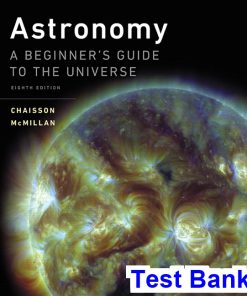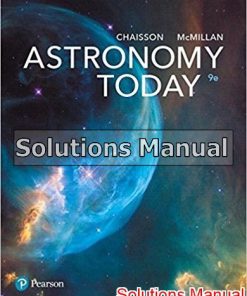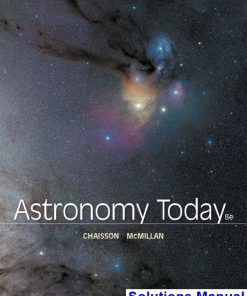1. The Night Sky
1.1 The Big Picture
1.2 The “Obvious” View
1.3 Earth’s Orbital Motion
1.4 The Motion of the Moon
1.5 Eclipses
1.6 The Scientific Method
2. Light and Telescopes
2.1 Radiation
2.2 The Electromagnetic Spectrum
2.3 The Radiation Laws
2.4 Spectroscopy
2.5 Atoms and Molecules
2.6 Optical Telescopes
2.7 Radio Telescopes
2.8 Space-Based Astronomy
3. The Solar System
3.1 Planetary Motion
3.2 Heliocentric Solar System
3.3 The Birth of Modern Astronomy
3.4 The Laws of Planetary Motion
3.5 Newton’s Laws
3.6 Measuring Our Planetary System
3.7 Solar System Overview
4. Earth And Its Moon
4.1 Bulk Properties of Earth and the Moon
4.2 The Moon and Tides
4.3 Inside Earth and the Moon
4.4 Earth’s Atmosphere
4.5 Surface Activity on Earth
4.6 The Surface of the Moon
4.7 Magnetospheres
5. The Eight Planets
5.1 Surfaces of the Terrestrial Planets
5.2 Water on the Terrestrial Worlds
5.3 Terrestrial Atmospheres
5.4 Jovian Atmospheres
5.5 Water in the Outer Solar System
5.6 Planetary Interiors
5.7 Jovian Magnetic Fields
6. Small Bodies In The Solar System
6.1 The Galilean Moons of Jupiter
6.2 Io: A Moon of Volcanoes
6.3 Moons of the Outer Jovian Planets
6.4 The Medium-Size Jovian Moons
6.5 Saturn’s Rings
6.6 Formation of Planetary Rings
6.7 Interplanetary Debris
6.8 Beyond Neptune
7. Formation of Planetary Systems
7.1 Formation of Planetary Systems
7.2 Planetesimals and Protoplanets
7.3 Formation of the Jovian Planets
7.4 Searching for Extrasolar Planets
7.5 Exoplanet Properties
7.6 Is Our Solar System Unusual?
8. The Sun
8.1 Properties of the Sun
8.2 The Solar Interior
8.3 Energy Transport in the Sun
8.4 The Solar Atmosphere
8.5 Sunspots
8.6 The Active Sun
8.7 Solar Energy
8.8 Solar Neutrinos
9. Measuring The Stars
9.1 The Solar Neighborhood
9.2 Stellar Luminosities
9.3 Stellar Temperatures
9.4 Stellar Sizes
9.5 The Hertzsprung—Russell Diagram
9.6 Extending the Cosmic Distance Scale
9.7 Stellar Masses
10. Star Formation and Evolution
10.1 Interstellar Matter
10.2 Theory of Star Formation
10.3 Observations of Star Formation
10.4 Evolution of a Sun-like Star
10.5 Red Giants, White Dwarfs
10.6 Stars More Massive than the Sun
10.7 Star Clusters
11. Stellar Explosions
11.1 Novae
11.2 Supernovae
11.3 Supernova Remnants
11.4 Formation of the Heaviest Elements
11.5 Neutron Stars and Pulsars
11.6 Gamma-Ray Bursts
11.7 The Cycle of Stellar Evolution
12. Black Holes
12.1 Gravitational Collapse
12.2 Einstein’s Theory of Relativity
12.3 A New View of Gravity
12.4 Curved Spacetime
12.5 Space Travel Near Black Holes 212
12.6 Observational Evidence for Black Holes
13. The Milky Way Galaxy
13.1 Our Parent Galaxy
13.2 The Size and Shape of the Milky Way
13.3 Surveying the Milky Way
13.4 Formation of the Milky Way
13.5 Galactic Spiral Arms
13.6 The Mass of the Galaxy
13.7 The Galactic Center
14. Galaxies
14.1 Observations of Normal Galaxies
14.2 Maps of Galaxies in Space
14.3 Galaxy Collisions
14.4 Hubble’s Law
14.5 Active Galaxies
14.6 Supermassive Black Holes
14.7 Dark Matter
14.8 Galaxy Origin and Evolution
15. Cosmology and The Universe
15.1 The Universe on the Largest Scales
15.2 The Expanding Universe
15.3 The Fate of the Cosmos
15.4 Cosmic Microwave Background
15.5 The Early Universe
15.6 Cosmic Inflation
15.7 Formation of Large-Scale Structure
Appendices
Appendix 1. Scientific Notation
Appendix 2. Astronomical Measurement
Appendix 3. Tables
Glossary
Answers to End-of-Chapter Questions
Answers to True/False and Multiple Choice Questions
Photo Credits/Text Permissions
Index
People also search:
Download full solution manual at: Astronomy The Universe at a Glance 1st Edition
Download full test bank at: Astronomy The Universe at a Glance 1st Edition
Download full solution manual + test bank at: Astronomy The Universe at a Glance 1st Edition
Download full test bank + solution manual at : Astronomy The Universe at a Glance 1st Edition
Astronomy The Universe at a Glance 1st Edition testbank download pdf
Astronomy The Universe at a Glance 1st Edition download scribd
Astronomy The Universe at a Glance 1st Edition solution manual download pdf













